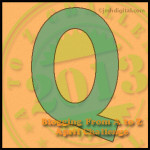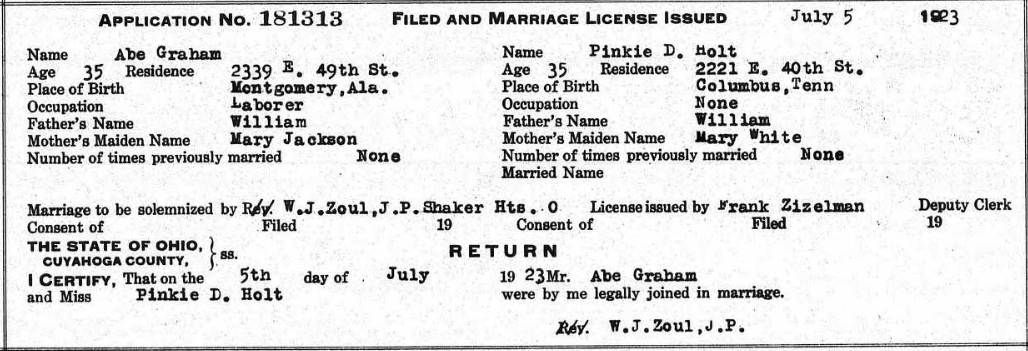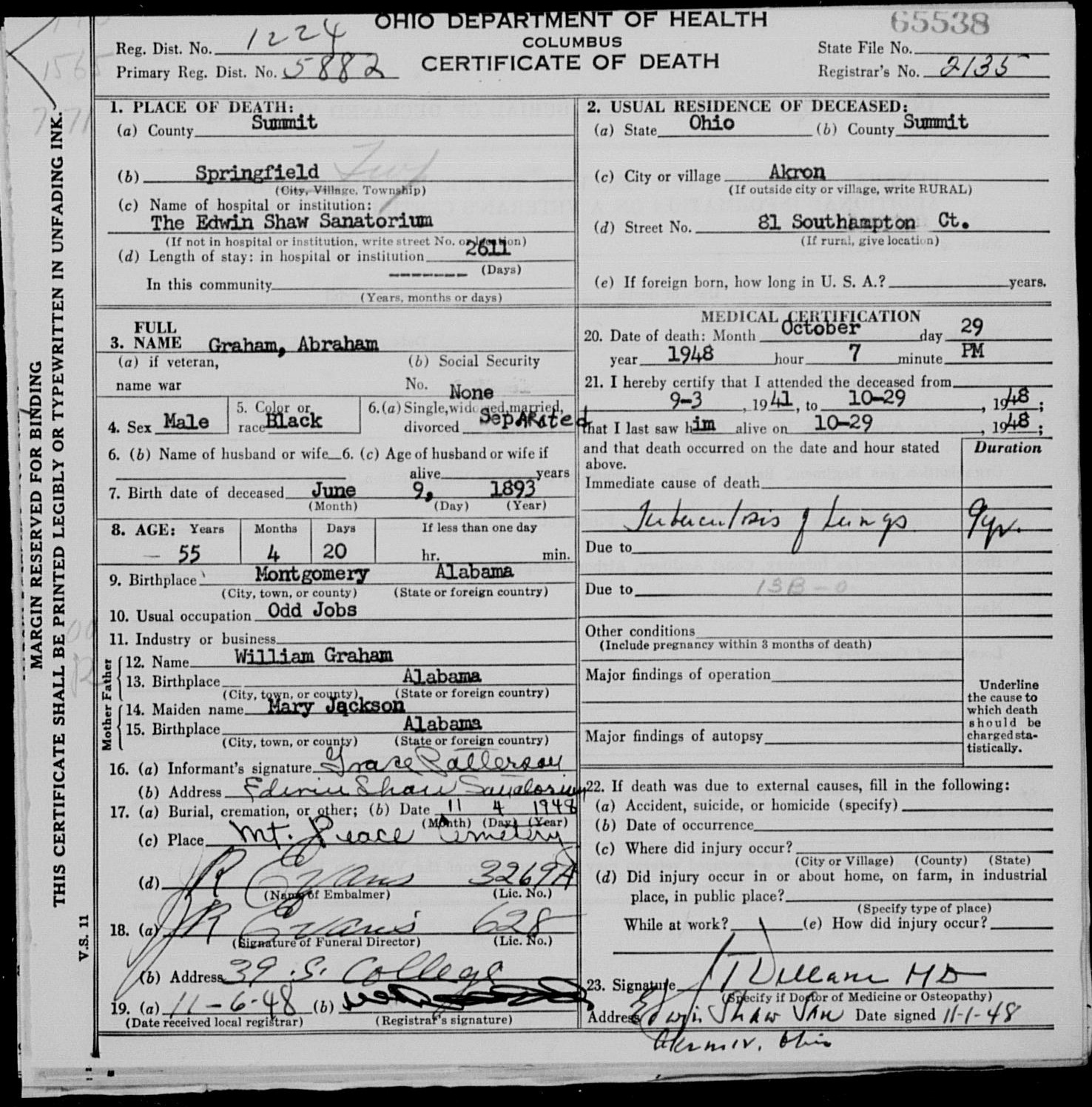This is the seventeenth post for the April A-Z Challenge. Finding a small New Testament, inscribed to Jacob Graham, in my grandfather Mershell C. Graham’s belongings, raised questions that I am still trying to answer. To read what I wrote earlier, follow this link, Jacob Graham. Today I am going to write about Zachries and Abraham Graham. Annie will get her own post soon. There is not much to write about Zachries, because I can’t find Zachries, Zakries, Zakery or Zak* anywhere, before or after 1900.
Abraham Graham
My first thought after finding Jacob Graham in the 1900 census in the household with Zachries, Annie and Abraham, was that, maybe Abraham was my grandfather being called by another name. I began to track him through the census records.
Abraham Graham was born about 1887 in Elmore County, Alabama, although he always listed place of birth as “Montgomery”. He completed 8th grade before moving to Nashville, Tennessee, where he worked in various jobs as a laborer. He was light enough to be mistaken for white, of medium height, slender, with grey eyes and dark brown hair.
My grandfather’s description in his WW1 registration: white, medium height, slender with grey eyes and dark brown hair.
Perhaps Abraham met his future wife, Pinkie Dorothy Holt while living in Nashville, where she was born and grew up. Or they could have met after both moved to Cleveland, Ohio. At any rate, in 1923, they were married in Cleveland, Ohio. He listed his parents as William Graham and Mary Jackson on the Marriage License. My grandfather listed William Graham and Mary Jackson on his delayed birth record as his parents.
Abraham continued to work as a laborer. He and his wife rented a house at 2278 E. 87th Street, where they lived for over ten years. They turned it into a boarding house, Dorothy ran it while Abraham worked as a truck driver. The house was full of her family and four or five lodgers. In 1940 there were 11 people living with them. They didn’t have any children. Follow this link to see them in the 1940 census.
In 1942, Abraham filled out his WW2 draft registration card from the Edwin Shaw Sanatorium. He was already suffering with the tuberculous that eventually killed him. He was described as 5 ft 11 in, 140 lbs with a sallow complexion, blue eyes and black hair. Race was first listed as “white”, crossed out and a check placed by “Negro”.
My grandfather’s description on his WW2 draft registration card: Race is checked as “white”. He complexion was light, height was 5 ft 9 in., weight 135 lbs with gray eyes and brown hair.
In May of 1943, Abraham’s wife, Pinkie Dorothy died of atypical pneumonia, sometimes called “walking pneumonia”. Katie Mayhue, one of the lodgers, was the informant on the death certificate.
On October 29, 1948 Abraham Graham died of tuberculous at the Edwin Shaw Sanatorium. His parents are, again, listed as William Graham and Mary Jackson.
He was buried in Mt. Peace Cemetery in Akron, Ohio on November 6, 1948. Was he my grandfather’s brother? What happened to William and Mary Graham? Where was my grandfather in 1900? What happened to Annie Graham, the other child in the 1900 Census? Stay tuned.
I used census records, draft registration cards, death certificates and marriage licenses from Ancestry.com, Family Search and my personal collections in writing this piece.




Questions are what makes genealogy fun. It seems like every time I find an answer, I also get a couple new questions.
I know! It’s nice to find the answers and move on to a new question though.
This is a fantastic geneaological detective story.
I wonder how I can solve it.
I will definitely “stay tuned.” I wish you luck in finding out all the answers to your questions.
Thanks Andrea. I hope so too.
as above great dective work – with possible results.
I had a quick look on 1940 census – did not find them.
-if listed as white, are the boarders – white or black?
-? could mean something or not with yr research.
-how are they listed or “head names” on the census?
is the neighbor mixed?…. just thoughts.
GJ
I added the link to their 1940 census page above. The whole household is identified as “Neg” short for “Negro”. The 1930 census was the first one where “Negro” was used in place of “black” and “mulatto”. I’m not trying to figure out if they’re “white” or “black”. I already know they are “black” (or “mulatto” or “Negro” or African American). I just find it interesting to see how the identifications can change depending upon who is doing the identifying so I add that in. If all the other information matches up with what I know, I don’t take the identifications as definitive or even knowledgeable. Does that make sense?
Aaaa I am so confused. This work is absolutely fascinating. Fascinating, too, that the War records list Abraham Graham as white. I wonder in which capacities he identified himself as white and in which circles that enabled him to move more freely? Perhaps it became second nature to live a kind-of double life; but perhaps that’s not so very different from what many of us find ourselves doing even today.
So, now you know that Abraham Graham was not your grandfather but still may have been related to him? I will have to go and read the back story, before your finding of the New Testament. I know nothing before my grandparents on my father’s side On my mother’s side, my uncle, in writing a history of the family, has managed to go back as far as my great-grandparents, but no further. I wonder how it changes your own sense of yourself, to be able to materialize your family more and more fully.
You have an amazing blog.
Sorry about the confusion. Abraham wasn’t listed as “white” on the draft registration card. They crossed out “white” and checked “Negro.” My grandfather was identifed as ‘white” on his draft registration card. Neither one of them identified as white in living their lives. I believe that what happened was that the person who filled out the cards assumed their race was “white”. The handwriting on the signature and the handwriting of the person who filled out the card was not the same.
I usually tell what race was filled on documents, including the census and other documents because it can change depending on who is doing the writing. Some censuses will identify people as “white”, sometimes as “Indian”, sometimes as “Mulatto”, sometimes as “black, sometimes as “Negro”, sometimes as “Mexican”. Sometimes the census taker asked but many times, perhaps most, they assumed. Why ask if you think you know?
I don’t know if it does or not. I have been able to go back on some branches through census records but without the stories and photographs I have for other branches it’s sort of frustrating. My hope is always that more cousins show up.
And yes, I realized Abraham was not my grandfather as soon as I found him in 1910 because my grandfather was somewhere else with his own name. I’m hopeful that one day I will slove the question of whether or not they were brothers.
Another excellent post. I love that family search now has digital deeds and probates from what they microfilmed in the 60s/70s. At least for NY they do.
History Sleuth’s Writings A to Z
Now if someone just composed the music we could use your blog title as the theme for family history!
It really is an intriguing question as to whether they were brothers or not – especially given the uncertainty about your grandfather’s family. From the certificates it would seem reasonable to assume so, but if that’s the case why are they not all together in one household -it’s not as if there was a huge number of children. As you say, questions, questions.
I agree with your point about assuming that the person filling out forms may not accurately represent the person’s name (spelling) or race or indeed other characteristics. Something we should keep in mind, but perhaps don’t always.
Pauleen at Tropical Territory
A to Z 2013
I should put one of my musical cousins on this. I just saw that part of your comment. sorry to be so late.